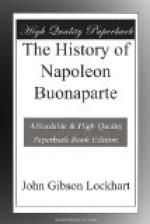Napoleon came up with the troops in pursuit of Moore at Benevente, on the 29th of December, and enjoyed for a moment the spectacle of an English army in full retreat. He saw that Moore was no longer worthy of his own attention, and entrusted the consummation of his ruin to Soult.
It excited universal surprise that the Emperor did not immediately return from Benevente to Madrid, to complete and consolidate his Spanish conquest. He, however, proceeded, not towards Madrid, but Paris; and this with his utmost speed,—riding on post-horses, on one occasion, not less than seventy-five English miles in five hours and a half. The cause of this sudden change of purpose, and extraordinary haste, was a sufficient one; and it ere long transpired.
CHAPTER XXVI
Austria declares War—Napoleon heads his army in Germany—Battles of Landshut and Eckmuhl—Ratisbonne taken—Napoleon in Vienna—Hostilities in Italy, Hungary, Poland, the North of Germany, and the Tyrol—Battle of Raab—Battle of Wagram—Armistice with Austria.... Progress of the War in the Peninsula, Battle of Talaveyra—Battle of Ocana—English Expedition to Walcheren.... Seizure of Rome and arrest of the Pope.... Treaty of Schoenbrunn.
Napoleon had foreseen that Austria, hardly dissembling her aversion to the “continental system,” and openly refusing to acknowledge Joseph as King of Spain, would avail herself of the insurrection of that country, necessarily followed by the march of a great French army across the Pyrenees, as affording a favourable opportunity for once more taking arms, in the hope of recovering what she had lost in the campaign of Austerlitz. His minister, Talleyrand, had, during his absence, made every effort to conciliate the Emperor Francis; but the warlike preparations throughout the Austrian dominions proceeded with increasing vigour—and Napoleon received such intelligence ere he witnessed the retreat of Moore, that he immediately countermanded the march of such of his troops as had




